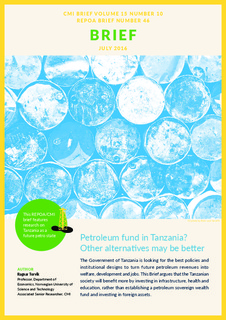| dc.description.abstract | The Government of Tanzania is looking for the best policies and institutional designs to turn future petroleum revenues into welfare, development and jobs. This Brief argues that the Tanzanian society will benefit more by investing in infrastructure, health and education, rather than establishing a petroleum sovereign wealth fund and investing in foreign assets.
Exploration for oil and gas in Tanzania started in the 1950s. The first discoveries were made in the 1970s, and commercial production started in 2004. Since 2010, additional huge reserves have been discovered offshore the southern coast. The size of the total confirmed gas reserves is currently standing at more than 57 trillion cubic feet. There are prospects for additional offshore, as well as onshore, reserves of both gas and oil. There is considerable uncertainty about the decision to invest in a liquefied natural gas (LNG) plant, the total volume of petroleum reserves, and the future petroleum prices.
The challenge
On average, countries with abundant reserves of petroleum are claimed to have lower economic growth, less democracy, more social unrest, and an erosion of their institutional quality. Such outcomes have sparked an interest in policy solutions to deal with these possible adverse effects of resource abundance. A main challenge with the literature on the so-called resource curse, however, is that it mainly describes the economic and political outcomes resulting from resource abundance, but is rather short on offering policy advice. Politicians and bureaucrats in petroleum producing countries, in contrast, have put major efforts into policy solutions and institutional designs to cope with possible unfavorable consequences of petroleum income. One dominant institutional design, which more and more petroleum producers seem to adopt, is to establish a petroleum fund.
A possible solution
The first petroleum fund established was the Kuwait Investment Authority in 1953. Later petrole | |
